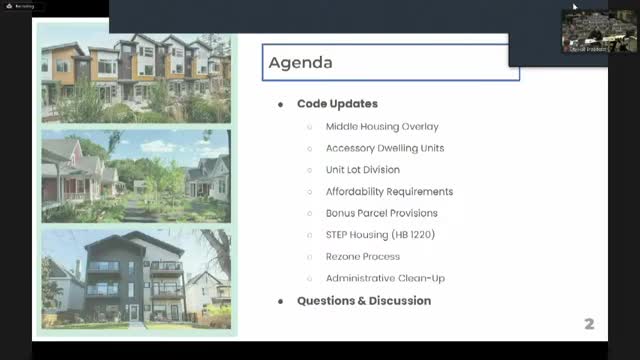City launches innovative plan for diverse middle housing options
August 29, 2024 | Sammamish City, King County, Washington
This article was created by AI summarizing key points discussed. AI makes mistakes, so for full details and context, please refer to the video of the full meeting. Please report any errors so we can fix them. Report an error »

In a recent government meeting, city officials outlined a comprehensive strategy for implementing middle housing, aimed at enhancing housing diversity and complying with state requirements under House Bill 1110. The plan introduces three overlay districts that will modify existing residential zoning regulations to facilitate the development of middle housing options.
The first overlay district, designated for R1 zones, will allow a density of three to four units per lot, irrespective of lot size. Developers can qualify for a bonus unit if they include an affordable housing unit on-site or if the existing home is preserved. Additionally, properties located within a quarter-mile of a transit stop will also be eligible for the fourth unit.
The second and third overlay districts will apply to the remaining residential zones, permitting a baseline of three units by right on all lots. For larger lots, a gross density regulation of 12 to 18 units per acre will be implemented, allowing for increased unit counts based on lot size.
The city has established a uniform floor area ratio requirement of 0.5 for existing single-family homes, with an additional 0.15 ratio for each unit beyond the first. This flexible approach is designed to accommodate various lot configurations and potential development scenarios, including new constructions, infill projects, and attached additions.
Officials emphasized that the regulations will differ based on the type of housing configuration—detached, attached, or stacked—ensuring that each development type adheres to specific standards tailored to its unique characteristics. This nuanced strategy aims to promote diverse housing solutions while addressing the city's evolving needs.
The first overlay district, designated for R1 zones, will allow a density of three to four units per lot, irrespective of lot size. Developers can qualify for a bonus unit if they include an affordable housing unit on-site or if the existing home is preserved. Additionally, properties located within a quarter-mile of a transit stop will also be eligible for the fourth unit.
The second and third overlay districts will apply to the remaining residential zones, permitting a baseline of three units by right on all lots. For larger lots, a gross density regulation of 12 to 18 units per acre will be implemented, allowing for increased unit counts based on lot size.
The city has established a uniform floor area ratio requirement of 0.5 for existing single-family homes, with an additional 0.15 ratio for each unit beyond the first. This flexible approach is designed to accommodate various lot configurations and potential development scenarios, including new constructions, infill projects, and attached additions.
Officials emphasized that the regulations will differ based on the type of housing configuration—detached, attached, or stacked—ensuring that each development type adheres to specific standards tailored to its unique characteristics. This nuanced strategy aims to promote diverse housing solutions while addressing the city's evolving needs.
View full meeting
This article is based on a recent meeting—watch the full video and explore the complete transcript for deeper insights into the discussion.
View full meeting
